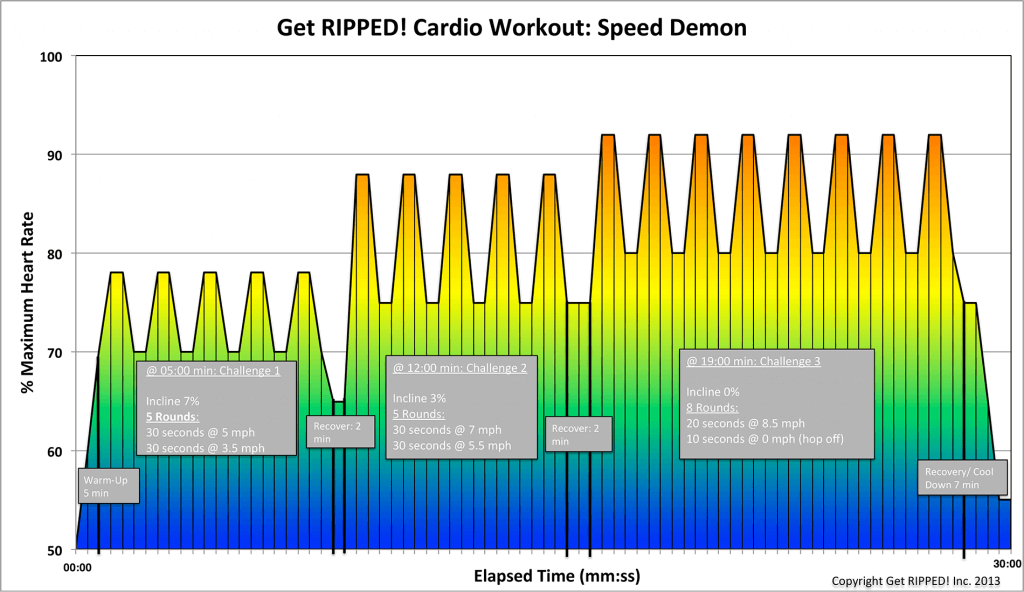Fitness Tips
Interval Training For Fast Results
Want to get more out of your workouts? Then try interval training for fast results!
There’s a little secret in the fitness world called interval training.
What is interval training? Rather than doing the same cardio exercise your entire workout, interval training alternates short, high-intensity bursts of exercise with slower, low-intensity periods of recovery.
Research has shown that such intervals of high and low-intensity activity burn more calories and build fitness quicker in a shorter amount of time. Once designed for elite athletes, interval training is now something the average fit person can try. You don’t need fancy equipment or special training to rev up your routine with interval training.
Read on to learn more about this fast, slow, fast, slow method of training and weight loss.
Theory Behind Interval Training
By alternating high-intensity movements with low-intensity movements, you’re working both your aerobic (with oxygen) and anaerobic (without oxygen) systems. High-intensity exercise causes your muscles to produce lactic acid (waste products), which lead to muscle soreness. Too much lactic acid build up causes exercise to become exhausting and painful.
Alternating hard and easy exercise will reduce the amount of lactic acid that accumulates, thereby making exercise more comfortable, improving your endurance and increasing your speed.
Interval Length
So how long should intervals be? The answer is, it doesn’t matter. There are no real hard-and-fast rules about interval length. Varying lengths bring varying benefits. So how fast and how often you pick up the pace depends on you.
Beginners should aim for no longer than 30 seconds of high-intensity bursts. If you’re feeling strong and are in good shape, go ahead and push yourself a bit longer.
Know the Risks
While a no-rules approach may sound appealing, interval training isn’t for the beginner. If you’re new in the land of fitness, take your time as you increase the intensity of your workouts. Rushing into high-intensity exercise may lead to injury. Start out slowly. Add one or two high-intensity intervals each workout. Slow down if you feel you’re overdoing it. As your stamina increases, feel free to challenge yourself.
Sample Workouts
Remember, there’s no set rule about how to do interval training. It can be tailored to your fitness level and type of exercise.
An interval-training workout involves four variables that can be changed to meet your goals: intensity of intervals, duration of intervals, duration of recovery intervals, and the number of interval repetitions.
Interval training can be casual, spur of the moment bursts of activity depending on how you’re feeling that day or if you’re working towards a more specific sports or fitness goal you can take a more sophisticated, scientific approach. Interval training workouts have been designed for plyometrics, sprints, stair running, jump rope, speed drills, and agility drills.
A simple example of interval training for walking would be to add short bursts of jogging or alternate slower walking with brisk walking. If you walk outdoors, you could jog or walk faster between certain landmarks such as mailboxes or street signs, then slow down for a short distance.
A second example that really gets your heart pumping and improves fitness in a short amount of time includes running, rowing, or cycling. Warm up for about 15 minutes, then run, row, or cycle as hard as you can (at 90 percent of your maximum heart rate) for three minutes. Then go easy for three minutes, allowing your body to recover. Repeat these three-minute intervals of high- and low-intensity exercise three or four times. Then cool down for 10 minutes.
Increase Your Intensity
To get the most out of your interval training try the following:
• Add Resistance. Between sets of cardio do a set with dumbbells, resistance bands or with your body weight.
• Increase Speed. Really push yourself during the sprinting intervals. Remember, it’s only a handful of seconds.
• Lengthen Intervals. Add a few seconds to your intense intervals.
• Change Exercises. If you’ve been sprinting then switch to burpees or high knees.
Here are WORKOUTS that help you increase your exercise intensity.


